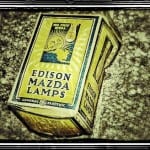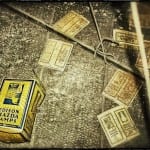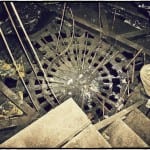a few afterthoughts on the exploration of the historic lawndale theater crawlspace.
This entry was posted on March 2 2014 by Eric
if my light source went dark, i would be in world of trouble. with a respirator, layer upon layer of clothing, clunky steel toe boots, tool belt and a headband flashlight, i began walking across this vast crawl space filled with criss-crossing structural iron trusses and a sea of incredibly dark and dusty plaster strung up by hundreds of steel rods...
atmospheric theaters were designed as an escape from the hardships of life during the depression. the squelching heat of summer, or perhaps the stress of living an impoverished life during these trying years set the stage for the creation of a highly embellished and massive space where the hardships of daily life would just fall to the wayside. you would get lost in some seaside village - all made of plaster with a cheerful polychrome or gilded finish. often times you would look up and see a vast ocean blue star-scape, consisting of small blinking lights arranged to mimic the constellations.
however, at the end of the day, it was all just a an elaborate illusion to comfort and/or shelter one from the harsh realities that would greet them upon exiting the theater.
if one of these ceiling "stars" burned out, a brave theater staff member, armed with a box of light bulbs and a flashlight would have to maneuver through a massive, uninviting dark and dank crawl space where trails consisting of haphazardly arranged boards would lead him towards those little blinking lights spread far and wide throughout this dangerous space high above the auditorium seating.
when i entered this crawlspace in chicago's historic lawndale theater on a cold winter day, decades later (the exant theater has been closed since the 1950's), all i could hear was myself breathing through a respirator and a multitude of tools knocking into each other against my tool belt. other than that, it was eerily quiet. as i walked along this catwalk all i could think about were the people before me, who over the years were given the unfavorable task of systematically changing out light bulbs embedded in the plaster below.
i held tightly to each rod as a took one step after another. i had my tools, but my lifeline was in my truck. damn it. if i were to lose my balance or step off of the catwalk, i would have crashed through about two inches of plaster, falling to my death against the auditorium seating fifty feet below.
i quickly discovered that each "star" light was located where a small mound of mazda boxes collected over the years. most of these boxes and the dead light bulbs were either general electric or westinghouse madza that dated to the 1930's. as i edged closer i was entranced by these bright yellow boxes strewn about - bearing logos of anthropomorphic suns smiling away at me - perhaps inviting me to look closer only to quickly realize that stepping off the trail meant dropping to my death.
i find great satisfaction when i look back and evaluate the thoughts that traveled around in my brain while wandering somewhat aimlessly (this was more of a reconnaissance mission the first few times) in this remarkable theater, which at one point in time, held thousands of theater goers who sat below me. did i feel their presence? no. i don't have time to consume myself in ghosts and all that other sort of boobery (e.g., chasing shadows, stumbling upon "cold spots" and other nonsense).
and now, many years later, the building is slowing dying, and i was the only one there to witness it - high up in this damn crawl space.
why the hell was i up there? two reasons: the first being if i'm preparing to salvage an old theater, i immediately search the back stage, basement and crawl spaces for old scenery, movie posters, lighting and so on. there always tends to be long forgotten gems tucked away by individuals who had the foresight to not carelessly discard something that clearly holds inherent beauty - in one form or another. the second reason is to figure out how my crew and i are going to remove the theater's artifacts (e.g., giant chandeliers , decorative plaster, signage and the like). so i map out the terrain in my brain and with my camera so i can then later review and determine the best options to begin removing artifacts in an orderly fashion. the safety of my crew ways heavily on my mind as well. i explain time and again what not to do. the last thing i would ever want is to look down through a punctured ceiling and see a lifeless body fifty feet below lying against auditorium seating. of course, i will bring in lifelines and other safety equipment as a precautionary measure, but in the early days, when the salvage was foolishly spearheaded by myself, i learned things the hard way - and have since paid for this with stitches, concussions and a back in desperate need of surgery.
i spent a great deal of time in that crawl space. i found old blueprints used to instruct the plasterers where to install component "a" or "b." i also discovered several milk bottles left all over the place (the embossed markings indicated a date around 1927), which i assume were likely consumed by the plasterers during lunch breaks and so on.
after numerous trips to that crawlspace, i came away with dozens of old mazda boxes, "tipped" light bulbs, movie posters (from 1936), a marquee sign and of course, the "star lights."
those lights, manufactured by the major electric equipment company of chicago, where utilitarian in design, and quite frankly, just unattractive. a single light was comprised of cold-rolled steel with a black enameled finish. a conical-shaped shade was inserted into the plaster. the tail end has a pin hole, that would allow a small amount of light through - seen by the audience below. the socket and housing were equipped with a "blinker" mechanism, bare bulb socket and steel conduit feeding like a snake from the backside. the staff worker would simply disconnect the light source from the embedded shade and replace the bulb. after reattaching the two-part light, he/she would move on to the next burned out light.
i removed several of these interesting contraptions. i cleaned them. i studied them. i was fascinated. i took many home. i hoarded them. what made an otherwise mundane object so incredibly cool was the story behind it, which in so many cases makes the object priceless - at least in my mind.
that narrative or story, told in one way or another through the urban remains website, offers meaning and context to artifacts that otherwise would have been destroyed and forgotten - thanks to the endless swing of the wrecking ball. not only do i present a salvaged object photographically, but in addition, i provide the context or story behind it. and more often than not, people like myself find the story to be equally as appealing as the object itself.
simply put, we are passionate about preserving this history. i have devoted my entire life to this process. despite lingering health issues and a patchwork of scars and the like, i wake up every day prepared to salvage and later research the next artifact that so deservingly needs its story told. otherwise, these artifacts just become unidentified and decaying objects in some landfill.
This entry was posted in , Miscellaneous, Salvages, Bldg. 51, Events & Announcements & Bldg. 51 Feed on March 2 2014 by Eric
WORDLWIDE SHIPPING
If required, please contact an Urban Remains sales associate.
NEW PRODUCTS DAILY
Check back daily as we are constantly adding new products.
PREMIUM SUPPORT
We're here to help answer any question. Contact us anytime!
SALES & PROMOTIONS
Join our newsletter to get the latest information



























